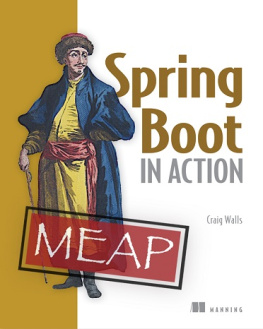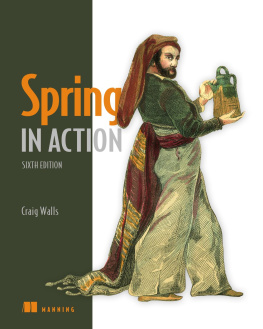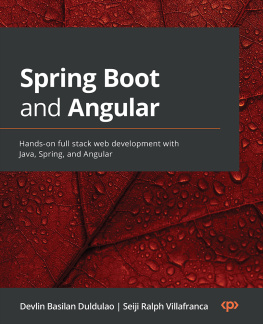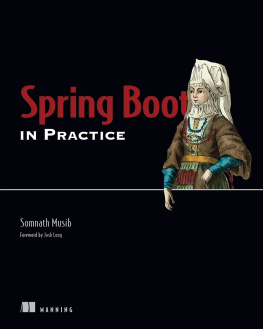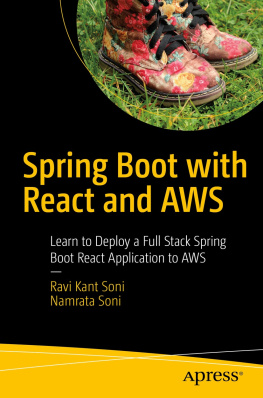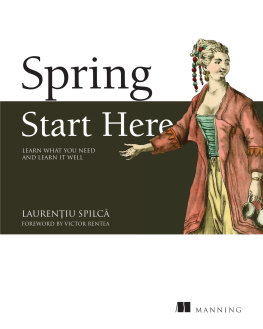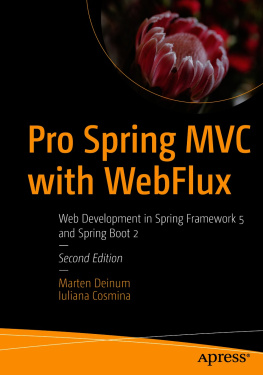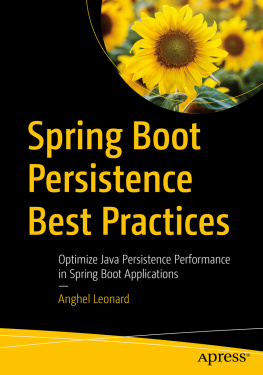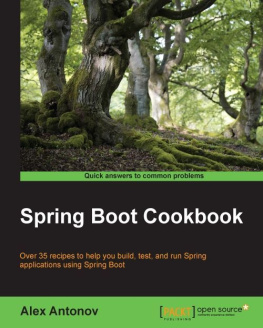Craig Walls - Spring Boot in Action
Here you can read online Craig Walls - Spring Boot in Action full text of the book (entire story) in english for free. Download pdf and epub, get meaning, cover and reviews about this ebook. year: 2016, publisher: Manning Publications, genre: Computer. Description of the work, (preface) as well as reviews are available. Best literature library LitArk.com created for fans of good reading and offers a wide selection of genres:
Romance novel
Science fiction
Adventure
Detective
Science
History
Home and family
Prose
Art
Politics
Computer
Non-fiction
Religion
Business
Children
Humor
Choose a favorite category and find really read worthwhile books. Enjoy immersion in the world of imagination, feel the emotions of the characters or learn something new for yourself, make an fascinating discovery.
- Book:Spring Boot in Action
- Author:
- Publisher:Manning Publications
- Genre:
- Year:2016
- Rating:5 / 5
- Favourites:Add to favourites
- Your mark:
Spring Boot in Action: summary, description and annotation
We offer to read an annotation, description, summary or preface (depends on what the author of the book "Spring Boot in Action" wrote himself). If you haven't found the necessary information about the book — write in the comments, we will try to find it.
Summary
A developer-focused guide to writing applications using Spring Boot. Youll learn how to bypass the tedious configuration steps so that you can concentrate on your applications behavior.
Purchase of the print book includes a free eBook in PDF, Kindle, and ePub formats from Manning Publications.
About the Technology
The Spring Framework simplifies enterprise Java development, but it does require lots of tedious configuration work. Spring Boot radically streamlines spinning up a Spring application. You get automatic configuration and a model with established conventions for build-time and runtime dependencies. You also get a handy command-line interface you can use to write scripts in Groovy. Developers who use Spring Boot often say that they cant imagine going back to hand configuring their applications.About the Book
Spring Boot in Action is a developer-focused guide to writing applications using Spring Boot. In it, youll learn how to bypass configuration steps so you can focus on your applications behavior. Spring expert Craig Walls uses interesting and practical examples to teach you both how to use the default settings effectively and how to override and customize Spring Boot for your unique environment. Along the way, youll pick up insights from Craigs years of Spring development experience.
Whats Inside
- Develop Spring apps more efficiently
- Minimal to no configuration
- Runtime metrics with the Actuator
- Covers Spring Boot 1.3
About the Reader
Written for readers familiar with the Spring Framework.
About the Author
Craig Walls is a software developer, author of the popular book Spring in Action, Fourth Edition, and a frequent speaker at conferences.Table of Contents
- Bootstarting Spring
- Developing your first Spring Boot application
- Customizing configuration
- Testing with Spring Boot
- Getting Groovy with the Spring Boot CLI
- Applying Grails in Spring Boot
- Taking a peek inside with the Actuator
- Deploying Spring Boot applications APPENDIXES
- Spring Boot developer tools
- Spring Boot starters
- Configuration properties
- Spring Boot dependencies
Craig Walls: author's other books
Who wrote Spring Boot in Action? Find out the surname, the name of the author of the book and a list of all author's works by series.

